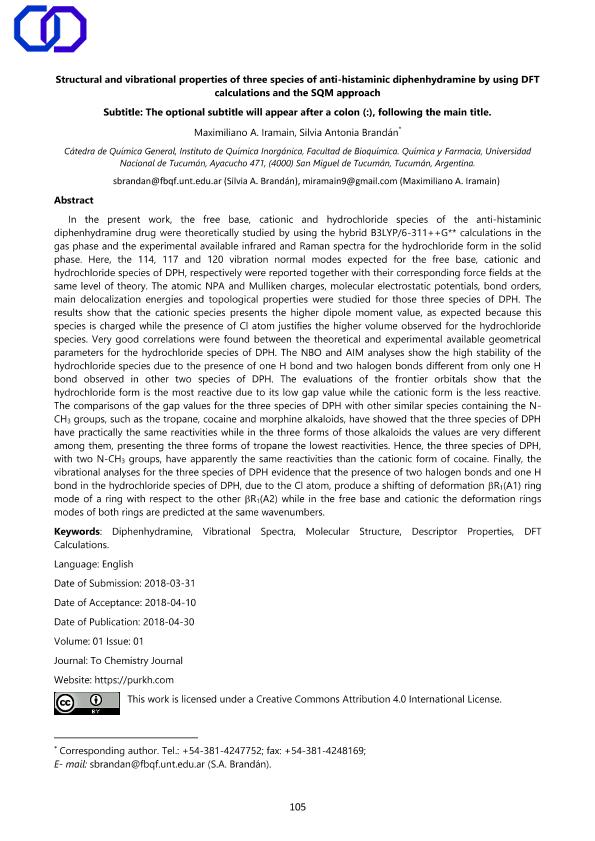Mostrar el registro sencillo del ítem
dc.contributor.author
Iramain, Maximiliano Alberto

dc.contributor.author
Brandan, Silvia Antonia

dc.date.available
2021-07-14T12:52:25Z
dc.date.issued
2018-04
dc.identifier.citation
Iramain, Maximiliano Alberto; Brandan, Silvia Antonia; Structural and vibrational properties of three species of anti-histaminic diphenhydramine by using DFT calculations and the SQM approach; Purkh; To Chemistry Journal; 1; 4-2018; 105-130
dc.identifier.issn
1916-9698
dc.identifier.uri
http://hdl.handle.net/11336/136075
dc.description.abstract
In the present work, the free base, cationic and hydrochloride species of the anti-histaminic diphenhydramine drug were theoretically studied by using the hybrid B3LYP/6-311++G** calculations in the gas phase and the experimental available infrared and Raman spectra for the hydrochloride form in the solid phase. Here, the 114, 117 and 120 vibration normal modes expected for the free base, cationic and hydrochloride species of DPH, respectively were reported together with their corresponding force fields at the same level of theory. The atomic NPA and Mulliken charges, molecular electrostatic potentials, bond orders, main delocalization energies and topological properties were studied for those three species of DPH. The results show that the cationic species presents the higher dipole moment value, as expected because this species is charged while the presence of Cl atom justifies the higher volume observed for the hydrochloride species. Very good correlations were found between the theoretical and experimental available geometrical parameters for the hydrochloride species of DPH. The NBO and AIM analyses show the high stability of the hydrochloride species due to the presence of one H bond and two halogen bonds different from only one H bond observed in other two species of DPH. The evaluations of the frontier orbitals show that the hydrochloride form is the most reactive due to its low gap value while the cationic form is the less reactive. The comparisons of the gap values for the three species of DPH with other similar species containing the N-CH3 groups, such as the tropane, cocaine and morphine alkaloids, have showed that the three species of DPH have practically the same reactivities while in the three forms of those alkaloids the values are very different among them, presenting the three forms of tropane the lowest reactivities. Hence, the three species of DPH, with two N-CH3 groups, have apparently the same reactivities than the cationic form of cocaine. Finally, the vibrational analyses for the three species of DPH evidence that the presence of two halogen bonds and one H bond in the hydrochloride species of DPH, due to the Cl atom, produce a shifting of deformation R1(A1) ring mode of a ring with respect to the other R1(A2) while in the free base and cationic the deformation rings modes of both rings are predicted at the same wavenumbers.
dc.format
application/pdf
dc.language.iso
eng
dc.publisher
Purkh
dc.rights
info:eu-repo/semantics/openAccess
dc.rights.uri
https://creativecommons.org/licenses/by-nc-sa/2.5/ar/
dc.subject
DIPHENHYDRAMINE
dc.subject
VIBRATIONAL SPECTRA
dc.subject
MOLECULAR STRUCTURE
dc.subject
DFT CALCULATIONS
dc.subject.classification
Otras Ciencias Químicas

dc.subject.classification
Ciencias Químicas

dc.subject.classification
CIENCIAS NATURALES Y EXACTAS

dc.title
Structural and vibrational properties of three species of anti-histaminic diphenhydramine by using DFT calculations and the SQM approach
dc.type
info:eu-repo/semantics/article
dc.type
info:ar-repo/semantics/artículo
dc.type
info:eu-repo/semantics/publishedVersion
dc.date.updated
2020-12-04T18:35:44Z
dc.journal.volume
1
dc.journal.pagination
105-130
dc.journal.pais
Canadá

dc.journal.ciudad
Toronto
dc.description.fil
Fil: Iramain, Maximiliano Alberto. Universidad Nacional de Tucuman. Facultad de Bioquimica, Quimica y Farmacia. Instituto de Quimica Inorganica. Cátedra de Química General.; Argentina. Consejo Nacional de Investigaciones Científicas y Técnicas. Centro Científico Tecnológico Conicet - Tucumán; Argentina
dc.description.fil
Fil: Brandan, Silvia Antonia. Universidad Nacional de Tucuman. Facultad de Bioquimica, Quimica y Farmacia. Instituto de Quimica Inorganica. Cátedra de Química General.; Argentina
dc.journal.title
To Chemistry Journal
dc.relation.alternativeid
info:eu-repo/semantics/altIdentifier/url/https://purkh.com
Archivos asociados
